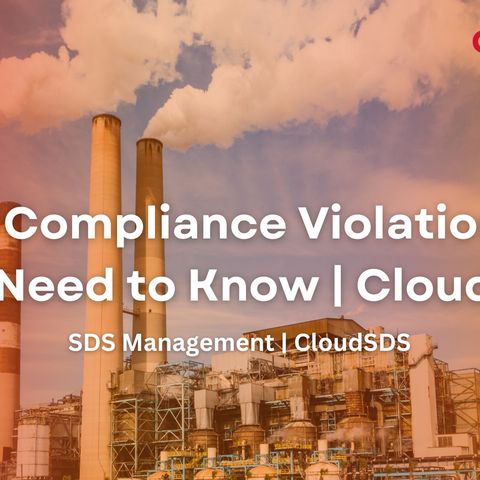Each facility handling hazardous chemicals must always have a proper
chemical management strategy. Apart from ensuring the safety and proper handling of the chemicals, the chemical manufacturing facilities must also ensure compliance with
Safety Data Sheets (SDS) regulations. It is critical as SDS compliance violations may lead to severe consequences. Chemical manufacturing companies are always working on a tight and tedious schedule. At the same time, they must also take care of their worker’s safety and ensure harmless practices to safeguard the environment. At the same time, they must also stay aware of all the regulations that regulatory agencies like the
Occupational Safety and Health Administration (OSHA) have mandated. At each stage, facilities should avoid SDS compliance violations. Due to the non-compliance, companies may face reputational damage and huge legal penalties. Can we eliminate non-compliance issues more quickly? Yes, there are ways, but they will only be possible if one has a solid grasp of
OSHA regulations. It also requires knowing all the mistakes that manufacturers may make. Continue reading the blog to know some of the common SDS compliance violations that chemical manufacturers must know. This blog will also guide you to find the right solutions to stay compliant with the regulations of OSHA. OSHA’s Regulations: Key to Avoid SDS Compliance Violations OSHA is a regulatory agency that surveys or inspects workplaces to ensure workers’ safety, mainly in areas where hazardous chemicals are present. The organization has mandated that employers notify employees of any possible risks associated with
hazardous materials. As per the agency, employers must ensure that their employees receive adequate training before their initial assignment. It’s the responsibility of OSHA to ensure worker safety. Ignore SDS Compliance Violations: The Regulations in BriefIndeed, handling the stressful workflow of every chemical manufacturing farm is tedious. However, a thorough knowledge of these regulations is a must to stay away from SDS compliance violations. So, take a look below and see what they are: 1. Providing Worker Education and Training: Each employee of a chemical manufacturing company must receive training. The training process must comply with the
standard decided by OSHA. Moreover, the agency has also prepared its Hazard Communication Standard( HCS). It’s designed to share adequate information with the workers through training. While preparing the training modules for the workers, facilities must keep in mind the following points:
- Workers must receive clear information about the identities and hazards of all the toxic chemicals at the workplace.
- Each employee must receive the actual and the associated protective measures to keep themselves and others safe in emergencies.
2. Remaining HCS Compliant: To avoid the consequences of SDS compliance violations, agencies must know HCS and stay compliant with it. According to the Hazard Communication Standard, facilities must keep in mind the following factors:
- Manufacturers must assess the hazards of the substances. To share the hazard information, they must prepare a Safety Data Sheet(SDS) and labels.
- The exposed workers must get proper access to the SDS and the labels.
3. Identification of Respiratory Hazards: Chemical manufacturing agencies must also consider the possible respiratory hazards in the workplace. It may hugely hamper the health of the workers if not addressed in the right way. For this reason, a proper evaluation is necessary to identify the respiratory threats. OSHA has also listed the various types of
Occupational Exposure Limits (OELs). Companies must stay aware of each one of them to stay away from the penalties they may face due to SDS compliance violations.
Read more: https://cloudsds.com/sds-management/sds-compliance-violation-all-you-need-to-know-cloudsds/

